Carbohydrates are the most important energy source to fuel the brain and body, since it's fast-acting and can be converted into ATP energy. When there is enough ATP for the body, excess carbohydrates are stored in the form of glycogen in the muscle and liver.
There are several pathways involved in the breakdown of carbohydrates which we will be diving into in this chapter.
Now that you know the fundamentals of carbohydrate metabolism we can look a little further into the key terms, definitions, and pathways that will be important for the MCAT.
Let’s get started!
Carbohydrate Metabolism on the MCAT: What You Need to Know
Introductory biochemistry accounts for 25% of the Biological and Biochemical Foundations of Living Systems section (Bio/Biochem) and 25% of the Chemical and Physical Foundations of Biological Systems section (Chem/Phys).
Carbohydrate metabolism questions will primarily appear in the Biological and Biochemical Foundations of Living Systems section of the MCAT. In this section, your understanding of the pathways themselves and the regulation of these pathways will be pivotal to ace relevant questions.
This review will provide you with a complete understanding of the key pathways, terminology, and regulatory mechanisms of carbohydrate metabolism.
Important Sub-Topics - Carbohydrate Metabolism
1. Glycolysis: Fundamentals
Glycolysis is the process that takes place in the cytosol of the cell, where one glucose molecule is oxidized into two pyruvate molecules. In addition to two pyruvates, glycolysis also produces two NADH (high energy electron carriers) and two net ATPs.
The pyruvates formed from glycolysis will either enter the mitochondria for oxidative phosphorylation, or it will remain in the cytosol for lactate fermentation.
The fate of pyruvates depends on oxygen availability. When there is adequate oxygen availability, pyruvates will enter the mitochondria and undergo oxidative phosphorylation. With lower oxygen availability, pyruvates undergo lactate fermentation.
Full Study Notes : Glycolysis: Fundamentals and Key Terms on the MCAT
For more in-depth content review on fundamentals and key terms, check out these detailed lesson notes created by top MCAT scorers.
2. Glycolysis: Enzymes and Processes
In general, the MCAT requires that you memorize all of the enzymes involved in glycolysis, and the names of the substrates/intermediates produced.
The MCAT may use the enzymes and substrates/intermediates of glycolysis in passage based questions or stand-alone questions, so being familiar with what reactions they are involved in is helpful for test day.
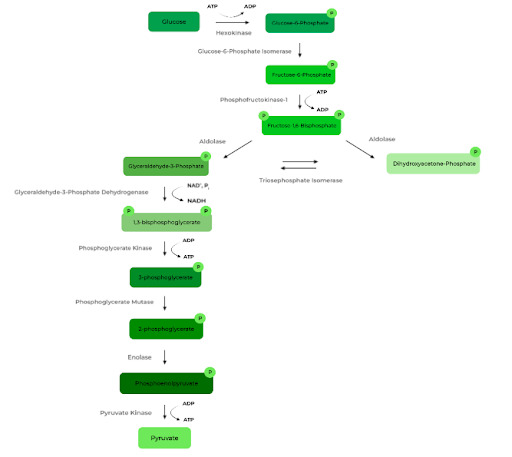
Importantly, enzymes that catalyze irreversible reactions (meaning they only catalyze the forward and not the reverse reaction) are extremely important to remember. In glycolysis these enzymes are:
Enzyme | Function |
|---|---|
Hexokinase | Catalyzes the ATP-dependent phosphorylation of glucose into glucose-6-phosphate. |
Phosphofructokinase | Catalyzes the ATP-dependent phosphorylation of fructose-6-phosphate into fructose-1,6,bisphosphate. |
Pyruvate Kinase | Catalyzes the ATP-dependent phosphorylation of phosphoenolpyruvate into pyruvate. |
Full Study Notes : Glycolysis: Enzymes and Processes on the MCAT
For more in-depth content review on enzymes and processes, check out these detailed lesson notes created by top MCAT scorers.
3. Oxidative Phosphorylation: Fundamentals
Oxidative phosphorylation is the production of ATP through aerobic respiration. This means that it requires oxygen for this process to occur.
It all starts when pyruvate passes through the outer mitochondrial layer and gets oxidized by the pyruvate dehydrogenase complex, turning both pyruvate molecules into acetyl-CoA molecules.
The acetyl-CoA molecules then enter the citric acid cycle where electron carriers will shuttle electrons to the electron transport chain (ETC).
Note: pyruvate oxidation and the TCA cycle both take place in the intermembrane space.
Full Study Notes : Oxidative Phosphorylation: Fundamentals and Key Terms on the MCAT
For more in-depth content review on fundamentals and key terms, check out these detailed lesson notes created by top MCAT scorers.
4. Pyruvate Dehydrogenase Complex
The pyruvate dehydrogenase complex is composed of three main and two regulatory enzymes which oxidizes each pyruvate into an acetyl-CoA.
The three main enzymes include:
The two regulatory enzymes include:
The most important enzyme in this complex is pyruvate dehydrogenase. Understanding how it is regulated will also be crucial for the MCAT.
At the end of pyruvate oxidation, one NADH and one CO2 are produced.
One NADH is produced per pyruvate. So, for every glucose molecule there will be two NADH produced during pyruvate oxidation — one per pyruvate produced from glycolysis.
Full Study Notes : Pyruvate Dehydrogenase Complex on the MCAT
For more in-depth content review on pyruvate dehydrogenase complex, check out these detailed lesson notes created by top MCAT scorers.
5. The Citric Acid Cycle
Also known as the Krebs or tricarboxylic acid cycle. The citric acid cycle is a process where acetyl-CoA is used to synthesize citrate, which is then oxidized to generate three NADH, one FADH2 and one GTP per acetyl-CoA.
The primary purpose of the citric acid cycle is to generate high energy electron carriers, which include NADH and FADH2.
Once created, these electron carriers are shuttled and oxidized at the inner mitochondrial membrane where the electron transport chain resides.
It will be important to memorize both the enzymes and substrates/intermediates of the citric acid cycle for the MCAT.
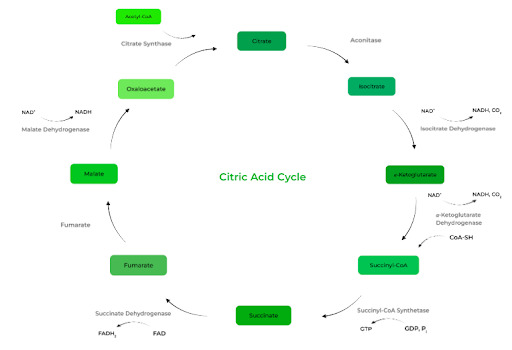
Full Study Notes : Oxidative Phosphorylation: Citric Acid Cycle on the MCAT
For more in-depth content review on citric acid cycle, check out these detailed lesson notes created by top MCAT scorers.
6. The Electron Transport Chain
The electron transport chain (ETC) is a complex composed of four enzyme complexes embedded in the inner mitochondrial membrane.
NADH and FADH2 will transfer their electrons to Complex I and Complex II, respectively,. As the electrons are transferred, this action will also pump the protons across the inner mitochondrial membrane to create an H+ electrochemical gradient.
The final electron acceptor is O2. Thish is why oxygen availability is a crucial component of oxidative phosphorylation taking place, instead of lactate fermentation.
Interestingly, Complex II of the ETC is succinate dehydrogenase. This is the same enzyme that catalyzes the conversion of succinate to fumarate in the citric acid cycle.
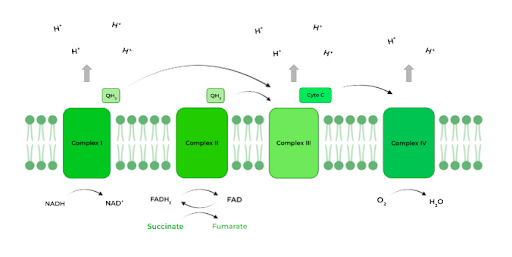
Full Study Notes : Oxidative Phosphorylation: Electron Transport Chain on the MCAT
For more in-depth content review on electron transport chain, check out these detailed lesson notes created by top MCAT scorers.
7. ATP Synthase
ATP Synthase is the enzyme that forms ATP by using the H+ electrochemical gradient created by the complexes of the ETC. The H+ ions will move down their electrochemical gradients from the intermembrane space to the inner mitochondrial membrane, which powers ATP synthesis.
To generate one ATP molecule, four protons are required to move through the inner mitochondrial membrane, down its electrochemical gradient, from the intermembrane space to the mitochondrial matrix.
For every NADH oxidized, 2.5 ATPs are produced. For every FADH2 oxidized, 1.5 ATPs are produced.
Full Study Notes : Oxidative Phosphorylation: ATP Synthase on the MCAT
For more in-depth content review on ATP synthase, check out these detailed lesson notes created by top MCAT scorers.
8. The Pentose Phosphate Pathway
The pentose phosphate pathway is a parallel pathway to glycolysis, shunting glucose-6-phosphate from its normal glycolytic pathway. Remeber, the glucose-6-phosphate is made when hexokinase catalyzes the phosphorylation of glucose.
Here, instead of glucose-6-phosphate being oxidized through glycolysis, it produces ribulose-5-phosphate and NADPH.
Ribulose-5-phosphate can be isomerized to ribose-5-phosphate to generate nucleotides. NADPH is important for fat synthesis.
Full Study Notes : Pentose Phosphate Pathway on the MCAT
For more in-depth content review on pentose phosphate pathway, check out these detailed lesson notes created by top MCAT scorers.
9. Carbohydrate Storage: Gluconeogenesis
Gluconeogenesis is the synthesis of glucose. It is the process where non-carbohydrate intermediates (e.g. lactate, glycerol, and amino acids) are used to create glucose.
Most of the enzymes used for gluconeogenesis are the same as in glycolysis, but instead of catalyzing the forward reactions (as they would in glycolysis) they catalyze the reverse reaction in gluconeogenesis.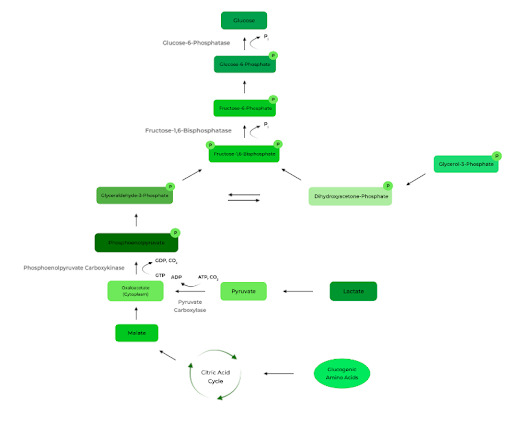
Full Study Notes : Gluconeogenesis on the MCAT
For more in-depth content review on gluconeogenesis, check out these detailed lesson notes created by top MCAT scorers.
10. Carbohydrate Storage: Glycogenesis
Glycogenesis is the process where the body stores excess glucose in the form of glycogen. It is important for the body to produce an accessible source of glucose so that we do not have to be constantly consuming food.
Glycogen is a polymer made of glucose monomers that are connected in a linear (α-1,4 glycosidic bonds) or branched (α-1,6-glycosidic bond) manner.
The steps of glycogenesis include:
1) isomerization of glucose-6-phosphate
2) activate the glucose monomer by attaching a uridine diphosphate group, to make a UDP-glucose
3) addition of UDP-glucose to the end of a glycogen via a linear (α-1,4 glycosidic bond)
4) a branching enzyme may then come in and hydrolyze a linear (α-1,4 glycosidic bond)
5) reposition the glycogen oligomer to form an (α-1,6 glycosidic bond).
It will be important to remember the enzymes and substrates/intermediates of this pathway for the MCAT!
Full Study Notes : Carbohydrate Storage: Glycogenesis on the MCAT
For more in-depth content review on glycogenesis, check out these detailed lesson notes created by top MCAT scorers.
11. Carbohydrate Storage: Glycogenolysis
Glycogenolysis is the process where glycogen (the a polymer) is broken down into glucose (the monomers) to meet the demand for energy between meals. It is essentially the reverse of glycogenesis.
The steps of glycogenolysis include:
1) hydrolysis of a terminal α-1,4 glycosidic bond
2) isomerization of glucose-1-phosphate into glucose-6-phosphate
3) glucose-6-phosphate enters gluconeogenesis and turns into glucose (in the liver and kidney) or glucose-6-phosphate enters glycolysis (in skeletal muscle).
Full Study Notes : Carbohydrate Storage: Glycogenolysis on the MCAT
For more in-depth content review on glycogenolysis, check out these detailed lesson notes created by top MCAT scorers.
12. Allosteric and Hormonal Regulation of Carbohydrate Metabolism
Enzymes of carbohydrate metabolism must be regulated through feedback pathways — when downstream products can feedback and affect an earlier step or component of the pathway.
This is either completed through a positive feedback or negative feedback mechanism.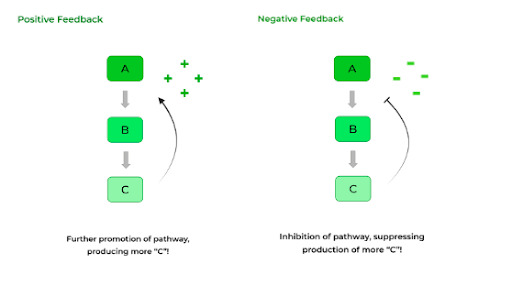
Full Study Notes : Allosteric and Hormonal Regulation of Carbohydrate Metabolism
For more in-depth content review on glycogenolysis, check out these detailed lesson notes created by top MCAT scorers.
Important Definitions and Key Terms — Carbohydrate Metabolism
Glycolysis
Term | Definition |
|---|---|
NADH (Nicotinamide Adenine Dinucleotide) | The reduced version of NAD+. NADH functions as a high energy electron carrier. During the oxidation of glucose, it gets oxidized at the electron transport chain to power ATP synthesis. |
ATP (Adenosine Triphosphate) | The cell’s main energy source. Produced through substrate level phosphorylation during glycolysis, and oxidative phosphorylation at the electron transport chain. |
Glycolysis | A 10 step process that results in the oxidation of 1 glucose into 2 pyruvates. It also produces NADH and ATP in the process. |
Lactate Fermentation | The pathway that pyruvates will enter under low oxygen availability. The primary purpose of lactate fermentation is to oxidize NADH→ NAD+ and recycle NAD+ through glycolysis to produce ATP anaerobically. |
Pentose Phosphate Pathway | A pathway that parallels glycolysis. Involves the conversion of glucose-6-phosphate into ribulose-5-phosphate (through a non-oxidative pathway) and NADPH (through an oxidativepathway), which are important molecules for nucleotide and fatty acid synthesis, respectively. |
Irreversible Enzymes/Steps | Enzymes that only catalyze the one way of a particular reaction. |
Oxidative Phosphorylation
Term | Definition |
|---|---|
Oxidative Phosphorylation | Aerobic production of ATP via flux through the electron transport chain. Requires adequate oxygen availability, as oxygen is the final electron acceptor. |
Chemiosmotic Gradient | The H+ electrochemical gradient. A process where protons are pumped from the mitochondrial matrix into the intermembrane space to create a difference in proton concentration across the inner mitochondrial membrane. |
Citric Acid Cycle | Also called the Krebs and tricarboxylic acid cycle. Produces more electron carriers (NADH and FADH2) in addition to GTP. |
Electron Transport Chain | Composed of 4 enzymes ( Complexes I, II, III, & IV) which are embedded in the inner mitochondrial membrane. Responsible for creating the chemiosmotic gradient. |
Carbohydrate Storage
Term | Definition |
|---|---|
Gluconeogenesis | Process where glucose is generated from non-carbohydrate sources, including lactate, glycerol, and glucogenic amino acids. |
Glucogenic amino acids | All amino acids except leucine and lysine. |
Glycogenesis | The formation of glycogen from excess glucose. |
Glycogen | A polymer of glucose monomers with both linear (α-1,4 glycosidic bonds) and branched (α-1,6 glycosidic bonds). |
Glycogenolysis | Refers to the breakdown of glycogen, releasing glucose monomers from the terminal end of glycogen. |
Insulin | A hormone that signals glucose uptake, glycolysis, and glycogenesis, decreasing blood glucose. |
Glucagon | An antagonist of insulin which promotes the breakdown of glycogen (glycogenolysis) and gluconeogenesis to increase blood glucose. |
Epinephrine | Stimulates glycogenolysis and gluconeogenesis to increase blood glucose. |
Hormonal Regulation of Carbohydrate Metabolism
Term | Definition |
|---|---|
Positive Feedback | Process where earlier steps of a reaction are stimulated to promote increases in downstream product formation. |
Negative Feedback | Process where the earlier steps of a reaction are inhibited to decrease the formation of downstream products. |
Additional FAQs — Carbohydrate Metabolism on the MCAT
What are the 4 stages of carbohydrate metabolism?
Should I memorize glycolysis for the MCAT?
What are the mechanisms of carbohydrate metabolism?
What are the 3 pathways of carbohydrate metabolism?
Additional Reading Links – Study Notes for Carbohydrates Metabolism on the MCAT
For more in-depth content review about carbohydrates metabolism on the MCAT, check out these detailed lesson notes created by top MCAT scorers!
Additional Reading: Biochemistry Subjects on the MCAT:
- Biological Membranes on the MCAT
- Amino Acids Peptides Proteins on the MCAT
- Carbohydrate Structure on the MCAT
- DNA and RNA on the MCAT
- Enzymes on the MCAT
- Lipids and Lipid Metabolism on the MCAT
- Non-Enzymatic Proteins on the MCAT
- Regulation of Metabolism on the MCAT
- Biotechnology on the MCAT
- Bioenergetics on the MCAT







 To help you achieve your goal MCAT score, we take turns hosting these
To help you achieve your goal MCAT score, we take turns hosting these 





















 reviews on TrustPilot
reviews on TrustPilot